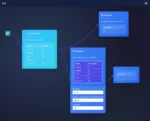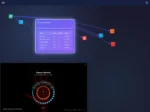
by tyler garrett | Jun 27, 2025 | Data Visual
In today’s rapidly evolving digital landscape, enterprises face complex questions that traditional data systems can’t effectively answer. Understanding relationships between various elements of your data isn’t just helpful—it’s essential. Enter graph database visualization. This dynamic technology allows businesses not only to store but to clearly see connections between datasets, uncover hidden insights, and drive innovation. Imagine being able to visually map intricate customer journeys, supplier dependencies, or operational networks effortlessly. Graph visuals deliver this clarity, empowering decision-makers to recognize trends, assess risks, and capitalize on opportunities faster. By harnessing relationship mapping at scale, enterprise leaders transform raw data into actionable intelligence, providing a strategic advantage in an increasingly competitive market.
The Rising Importance of Graph Databases for Enterprise Data Strategies
Graph databases have emerged as a crucial tool in the enterprise data strategist’s toolkit, surpassing traditional relational databases when it comes to capturing and exploring multifaceted relationships. Unlike conventional relational databases that store data in tables with rigid, predefined schemas, graph databases offer flexibility through structures consisting of nodes, relationships, and properties. This structure inherently focuses on relational connectivity, making it ideal for complex relationship discovery—the kind commonly encountered in enterprise-scale data.
For many enterprises, this transition has become increasingly necessary. As described in our article covering Business Capability to Data Asset Mapping Registry, mapping assets to core business competencies is foundational. Graph technologies build upon this concept by visually mapping not only business capabilities but also the intricate interdependencies that exist across enterprise datasets, integrations, stakeholders, and digital resources.
From detecting fraud in financial transactions, managing large-scale logistics networks, or mapping digital transformation roadmaps, graph databases provide unparalleled insights into complex enterprise problems. Empowered by these insights, decision-makers gain a significant strategic advantage over competitors relying exclusively on legacy databases for analytics and reporting.
Visualizing Complex Relationships: Making Big Data Intuitively Accessible
At enterprise scale, data complexity can become overwhelming—even for seasoned data analysts. Graph visualization technology bridges the gap between raw data and actionable insights by employing clear, visually engaging models. Data visualization tools like Tableau, as detailed extensively in our insights piece, Tableau Desktop and Tableau Data Extract BI Software, help turn detailed data into interactive visual analytics. Graph database visualizations amplify these abilities further by explicitly mapping relationships and dependencies.
With simplified, user-friendly visualizations, stakeholders across varying proficiency levels can intuitively understand complex relationships without technical training. Analysts, decision-makers, and executives can visually pinpoint critical themes and business-link relationships amongst customers, suppliers, products, and market data. Effective visualization democratizes data-driven decisions across business units and promotes proactive rather than reactive decision-making.
Date dependencies, integration complexities, and nuanced business rules can indeed become overwhelming; visual graph caching transforms this complexity into easy-to-understand global views. To streamline user experiences further, transparent data sharing policies as addressed in our article about Building Trust with Users through Transparent Data Sharing, ensure enterprise-wide accessibility and usability, fostering a data culture centered on trust and collaboration.
Enterprise-level Challenges Solved by Graph Database Visualization
Graph visualization directly addresses many unique enterprise-level challenges that traditional tools struggle with. Such challenges include real-time fraud detection, operational resilience planning, regulatory compliance tracking, and complex supply chain mapping. Financial institutions, for example, utilize graph-shaped queries to detect suspicious transaction patterns rapidly—something extremely cumbersome when queried via traditional methods. Similarly, visualizing extensive supply chains can pinpoint disruptions or risks before they escalate.
Visualizing relationships can reduce redundancy and expose vulnerabilities. Our piece on achieving cost-effective data movements using Zero-Copy Integrations: Minimizing Data Movement Costs exemplifies the kind of optimization possible at enterprise scale by leveraging graph models. Graph database insights also dramatically improve data lineage transparency, helping businesses quickly understand and comply with changing regulatory environments.
Moreover, complex business rules or evolving organizational frameworks frequently contribute to disconnected data silos. Graph visualizations aid enterprises in integrating disparate systems and overcoming silos by clearly illustrating the logical relationships across applications and databases, paving the way for cohesive data strategies.
The Role of Cloud Computing and Ephemeral Environments in Graph Visualization
Robust cloud computing platforms have fueled the ability to perform large-scale graph database computations, offering innovative solutions like ephemeral computing to handle bursts of intense analytic workloads. Choosing the appropriate cloud infrastructure is critical—a decision we explain further in our GCP Consulting Services. Cloud-based environments significantly simplify deploying highly complex representations, enhancing scalability and making graph database visualizations achievable enterprise-wide.
The agility offered by ephemeral environments—an ideal solution we previously discussed in the context of Ephemeral Computing for Burst Analytics Workloads—allows businesses to adapt seamlessly to fluctuating analytic demands without over-investing in persistent infrastructure. Graph-based computations often require powerful processing for short durations; cloud providers respond efficiently to these fluctuating demand patterns, delivering cost-effective performance.
Enterprise data architects and CIOs now have platforms capable of scaling effortlessly. Investing strategically in graph visualizations interoperable with cloud-based services empowers intelligent and responsive decision-making, ensuring that technical capabilities remain agile, performant, and resilient in the face of growth and changing organizational needs.
Critical Considerations When Adopting a Graph Database Visualization Solution
Although graph database visualization provides transformative benefits, the transition also necessitates thoughtful consideration before choosing solutions. As we emphasize with clients in our foundational guide, The Questions We Ask Clients Before Writing a Single Line of Code, achieving alignment between tool choices and business objectives remains essential.
Key considerations include evaluating the complexity of desired analyses, scalability requirements, integration compatibility, security provisions, and user accessibility levels across an organization. Security mechanisms—such as effective Dynamic Data Masking for Role-Based Data Access—must be robust to protect sensitive relationships, personal data, or proprietary corporate strategies from unauthorized access.
Another strategic decision revolves around ETL (extract-transform-load) processes and solutions. Selecting ETL tools influences how easily data can flow into these graph databases, ensuring maximum accuracy and integrity when data is visually mapped. Enterprises should thoroughly assess various solutions by reviewing our insights on both How to Choose the Right ETL Tool for Your Business and the practical Comparison of Open-source and Commercial ETL Solutions.
Implementation and Strategic Adoption: Leveraging Visual Insight for Innovative Advantage
To drive smart adoption, enterprises should approach graph database visualization as a foundational piece of their broader enterprise data strategy. Building a robust framework requires iterative versioning and intelligent deployment strategies, ideas we cover comprehensively in our guide on Enterprise Data Model Versioning and Deployment. A step-wise approach enables iterative refinement of graph integrity, visualization quality, and analytics capability based on user feedback and evolving needs.
Ultimately, the enterprise benefits from coherent combination—data governance, high-quality visualizations, accessible analytics, and cloud-enabled computational power—that fuels innovation. Enterprises leveraging graph visualization successfully uncover hidden efficiencies, deliver competitive differentiation, and convert complex, multi-dimensional datasets into strategic insights that drive real-time business agility.
Graph Database Visualization scales seamlessly in today’s enterprise environment, allowing businesses not only to represent their data clearly and intuitively but to power sophisticated decision-making processes and strategies. The differentiating factor lies in leveraging relationship mapping strategically and purposefully. With the right visual insight, enterprises gain powerful competitive advantages, enabling smarter decisions that align closely with core strategic objectives.
Thank you for your support, follow DEV3LOPCOM, LLC on LinkedIn and YouTube.

by tyler garrett | Jun 27, 2025 | Data Visual
In today’s data-driven marketplace, performance counts more than ever—and digital content analytics are the decisive factor in any successful marketing strategy. As digital marketers produce volumes of content across numerous channels, gaps in performance visibility can easily creep in, obstructing proper strategic decision-making. That’s where powerful visualization tools come into play, simplifying complex datasets into visually intuitive insights and actionable decisions. Leveraging these tools, decision-makers can rapidly pinpoint effective strategies, optimize customer journeys, and unlock new growth avenues to thrive amid intense market competition. Let’s unravel the mysteries of visualization technologies transforming digital marketing analytics today, guiding you through essential tools and cutting-edge patterns that empower your content performance analysis.
Why Visualization Matters: Unmasking Your Analytics Potential
Understanding content performance analytics revolves around effectively viewing and interpreting large, complex datasets. Simply put, digital marketers confront enormous volumes of data daily—click-through rates (CTR), conversion rates, social engagement metrics, traffic sources, audience segmentation, and more. Trying to parse through spreadsheets and tables rapidly becomes untenable and slows down critical decision-making processes.
Visualization tools solve this issue by transforming raw data into clean, understandable graphical formats. Compelling visuals—like heatmaps, bar charts, ternary plots for compositional data, and interactive dashboards—allow marketers and executives alike to easily spot trends, outliers, or shifts requiring strategic attention. Patterns hidden beneath dense data sets instantly jump to clarity, empowering better-informed decisions.
When effectively integrated into a cohesive pipeline—potentially assisted by professional data engineering consulting services—these visualization solutions streamline analysis and enhance agility, giving firms a strategic edge. Visualization shines a clear spotlight on return-on-investment (ROI), operational performance, customer behavior, and even competitive positioning, significantly strengthening resource allocation and actionable insight generation.
Top Visualization Tools Elevating Digital Marketing Analytics
Tableau: Robust Dashboards, Intuitive UI
Tableau remains a market leader in business intelligence visualization thanks to its advanced yet intuitive interface. For marketers, Tableau simplifies the reporting of digital marketing KPIs, unites diverse datasets, and clearly represents complex marketing funnels, in-depth customer journeys, and audience segmentation visuals. Its drag-and-drop format minimizes technical overhead, allowing stakeholders without technical backgrounds to quickly comprehend campaign efficacy. Advanced features such as predictive analytics, cohort analysis, and easy integration with mainstream marketing platforms make Tableau highly valuable for modern marketing teams.
Google Data Studio (Looker Studio): Cost-Effective and Accessible
Google Data Studio—now integrated into Google’s broader Looker Studio offering—has surged in popularity due to its affordability, cloud-based approach, and seamless integration into Google’s ecosystem. With simple report-sharing capabilities, robust templates, and connectors to services like Google Analytics, Search Console, Ads, and more, marketing analysts can automate key visualization workflows swiftly. While lighter in features than Tableau, Data Studio substantially reduces barriers for teams looking to implement quick-win visualizations without extensive initial investment.
Power BI: Seamless Microsoft Ecosystem Integration
Microsoft’s Power BI is powerful for marketers predominantly relying on a Microsoft-based tech infrastructure. Power BI’s strength lies in sophisticated analytic capabilities such as sentiment analysis, content performance forecasting, and rapid drill-down reporting directly embedded within Microsoft Teams and Office. Interactive visualizations facilitate storytelling, enabling marketers to dynamically explain performance variances and inform targeted campaigns. Its ability to seamlessly integrate with SQL servers, Excel sheets, and Azure cloud databases makes it indispensable for comprehensive digital marketing analytics at scale.
Advanced Visualization Patterns for Real-Time Digital Marketing Insights
Digital marketing has evolved beyond static metrics. Real-time analytics visualization now takes precedence, giving marketers actionable feedback moments after content deployment. Leveraging patterns for effective real-time visualizations has thus become pivotal. Approaches like microservice telemetry aggregation, where real-time insights from various channels aggregate into central dashboards, allow marketers swift evaluation and responsive adjustments.
Additionally, marketers can optimize their visual representations through interactive patterns provided by advanced visualization libraries, including D3.js. Techniques like force-directed simulations from D3.js can enhance network visualizations, revealing connections among customer segments, content effectiveness, and channel engagement in new insightful ways. This dynamism not only situates content in context clearly but also enables discovery of hidden relationships and relevance among datasets crucial for strategic decision-making.
By proactively adopting interactive visualization patterns, digital marketers can confidently shift strategy or accelerate tested content, capturing customer attention with unparalleled agility compared to competitors who stick with outdated, lagging analysis methods.
Ensuring Robustness with Forward and Backward Compatible Schema Evolutions
Proper visualization and insights rely heavily upon consistently structured, quality data. Over time, data schemas inevitably evolve—new marketing channels develop, analytics requirements shift, and business priorities constantly realign. Digital marketers who understand the importance of advanced data engineering practices like schema evolution with forward and backward compatibility find their analytics systems more robust, resilient, and reliable.
Ensuring schemas seamlessly adapt as new data sources or metrics emerge allows visualization dashboards to integrate seamlessly and remain reliable despite complex data shifts. Advanced schema evolution techniques permit marketers to avoid disruptions caused by incompatible integrations or breaking changes, ultimately safeguarding accurate analytics continuity and protecting the integrity of decision-making processes. Engaging with experienced data partners to implement robust schema evolution approaches guarantees greater long-term visualization effectiveness.
Security, Governance, and Empowered Self-Service Analytics
Developing exceptional visualization systems with comprehensive analytics capabilities requires strong attention to governance, compliance, and security considerations, ensuring sensitive marketing performance data remains secure yet accessible. Digital marketers adopting robust self-service data access request workflows establish secure governance foundations while promoting agile analysis processes across marketing teams to streamline decision-making.
Additionally, marketers should recognize the inherent value of clearly defined technical implementations around data sharing agreements. Consistent, clearly understood arrangements between stakeholders foster secure cooperation while tightly governing access, usage, and privacy compliance—critical components of building trust across analytics environments. Visualization remains valuable only when data democratization meets vigilant adherence to security and governance policies, minimizing costly compliance or security violations.
Ultimately, embracing these foundational governance practices ensures your visualization tools remain strategic assets, empowering marketing teams to analyze and efficiently leverage persuasive insights without jeopardizing organizational data integrity.
Fostering Collaboration Between Data Engineers and Analysts
In the era of advanced analytics, collaboration is paramount to drive meaningful visualization strategies. Understanding clearly the distinct differences between data engineers and data analysts and fostering seamless collaboration between these roles enhances visualization effectiveness considerably. Data engineers provide robust foundations, developing and maintaining infrastructure that fuels strong analytics pipelines, while analysts primarily interpret data, generate insights, and guide strategic decisions.
Teams investing in fostering transparency and collaboration between these key roles build integrated workflows, streamline visualization processes, and propel marketing analytics capabilities to new heights. Encouraging continuous multidisciplinary collaboration converts data-savvy teams into proactive strategic partners, continually optimizing marketing strategies and content performance based on real-time, visually communicated insights.
Transform the Way You Leverage Digital Marketing Analytics Today
Visualization tools, patterns, and best practices do more than improve your reports; they enhance strategic agility, accelerate growth, and unlock potent insights hidden within vast market data sets. Harnessing the power of analytics visualization empowers digital marketing decision-makers like never before. Committed to data-driven innovation, your organization can translate visual analytics into powerful competitive advantages, effectively navigating evolving audiences, channels, and market demands. It’s time to take content analytics beyond spreadsheets: Visualize smarter. Act faster. Win bigger.
Thank you for your support, follow DEV3LOPCOM, LLC on LinkedIn and YouTube.

by tyler garrett | Jun 27, 2025 | Data Visual
Imagine walking into a high-stakes business meeting armed not just with intuition but real-time insights drawn directly from biometric data—instant analytics that literally reflect your physical state. Wearable devices aren’t just smart gadgets anymore; they are vital analytics platforms transforming our interaction with real-time biometric data visualization. Business leaders and technology strategists should delve deeper into these transformative analytics tools, harnessing their power to drive smarter, quicker, and more confident decision-making in business operations and product innovations.
The Rise of Wearable Technology in Data Analytics
Wearable devices organically transitioned from niche fitness tracking gear to professional-grade analytics platforms, thanks to advances in sensor precision and data processing capabilities. Today, these sophisticated tools capture an exhaustive array of vital signals—heart rate variability, electrodermal activity, sleep patterns, and even complex stress indicators. Businesses leveraging wearable device analytics are unlocking real-time insights that revolutionize workplace productivity, safety protocols, and employee health management.
Whether shaping corporate wellness programs or enhancing user experience through real-time feedback loops, wearable analytics drive informed decisions backed by credible, personalized biometric data. For instance, integrating these data streams with robust backend architectures—such as those incorporating effective reference data management system architecture—allows businesses to manage and analyze high-volume sensor data securely and effectively, ensuring seamless scalability to enterprise-level applications.
Forward-thinking organizations are increasingly turning to wearable analytics platforms to foster a healthier, more productive workforce, ultimately translating biometric insights into enhanced organizational efficiency. Moreover, analyzing collective biometric data can identify broad behavioral trends, allowing proactive policy formulation and timely interventions. Organizations prioritizing data-driven innovation can gain a definitive competitive advantage, positioning themselves as industry pioneers—readily embracing technological evolution instead of reacting defensively to market shifts.
Visualizing Biometric Data: Transforming Complexity into Clarity
The true power of wearable technology lies in the capacity to visually present biometric data accurately and intuitively, converting raw numerical data into actionable business insights. Effective data visualization through dashboards and real-time analytics enables users to quickly grasp complex health metrics and trends, fostering an immediate understanding of individual and organizational performance indicators.
Advanced visualization solutions, such as interactive dashboards equipped with dynamic charts, personalized heat maps, or emotion inference visuals, move beyond simplistic metric presentations. They embed biometric patterns within broader contextual analyses, allowing businesses to pinpoint specific insights from the mass of streaming health data. However, as outlined by leading data strategists, knowing how to kill a dashboard before it kills your strategy is essential. Overloaded dashboards rarely drive smart decisions—instead, it’s meaningful, actionable, and selectively visualized data that ensures strategic clarity and successful business outcomes.
Furthermore, employing innovative and visually appealing techniques like intentionally designed word clouds or creative visual timelines helps stakeholders intuitively recognize overt and subtle shifts in biometric data trends. Such visual interpretations can significantly enhance the user experience, engaging stakeholders beyond traditional data analytics means. Ultimately, clear and insightful biometric data visualization becomes an indispensable tool in strategizing short-term action plans, long-term health initiatives, and tactical innovation decisions.
Integrating Wearable Analytics with Enterprise Applications
Businesses aiming to leverage biometric data visualization must first address integration challenges concerning real-time data analytics and internal enterprise systems. It’s crucial to partner with skilled technology strategists who clearly understand evolving ecosystems, such as cloud data integration, API developments, and IoT infrastructures. Leveraging professional Node.js consulting services can prove highly effective in securely managing and streamlining real-time data captures while optimizing backend operations and system responsiveness.
Meanwhile, strategic integration empowers businesses to unlock analytics features across diverse applications such as human resources platforms, CRM integration, product usability assessment, and personalized customer-health analytics. For example, integrating biometric data within site reliability platforms enables teams to quickly gauge emotional and stress-related insights during critical product issues, ensuring rapid responsiveness and risk mitigation.
However, integration alone is insufficient; successful biometric analytics strategy hinges on robust project management disciplines. As recognized in our insights on why organizations should stop blaming the data team and reconsider project management, businesses must establish clear roles, responsibilities, and alignment between technology implementation teams and operational stakeholders. This ensures effective implementation, optimized collaboration, and the accelerated realization of value-driven analytics outcomes, ultimately driving superior business agility.
Navigating Privacy, Ethics, and Data Governance in Biometrics Analytics
Biometric data, inherently sensitive and personal, demands stringent attention to privacy regulations and ethical best practices. Global discussions on data privacy concerns are rapidly evolving, necessitating constant vigilance and proactive adaptation. Strategic leaders must embrace a holistic approach to data governance, guided firmly by regulatory frameworks and expert analysis on the future of data regulation and privacy standards. Businesses must anticipate evolving policies, adapting swiftly to changing compliance requirements globally, to safeguard corporate reputation and consumer trust markably.
Ensuring data transparency, explicit user consent, robust security mechanisms, and anonymization techniques is paramount when deploying biometric analytics platforms. Building user confidence around how biometric data is captured, analyzed, and visualized becomes instrumental in operational success. Businesses that couple transparency with communication about the purpose and usage of biometric insights effectively establish trustworthy relationships with employees, partners, and customers.
Moreover, embedding data ethics deeply within analytics infrastructures allows leaders to proactively mitigate risks associated with data misuse, biases, and algorithmic unfairness. Embracing ethical vigilance ensures systems are fair, safe, and conducive to transparency, enabling long-term sustainable analytic initiatives. A mature and ethical data strategy turns biometric visualization platforms into corporate assets rather than potential liabilities, yielding lasting competitive advantage.
Smart Decisions in the Era of Wearable Analytics: Knowing the Limits
As powerful as biometric insights from wearable devices can be, it’s essential to maintain realistic expectations around the technology’s decision-making capacities and limitations. Strategists and decision-makers must acknowledge that “data-driven” does not inherently translate to smarter choices. In fact, as detailed insightfully in our discussion on why data-driven doesn’t always mean smart decisions, it’s holistic perspective, experiential expertise, and strategic analysis that impart true meaning to analytical outcomes.
Today’s leaders ought to interpret biometric visualizations within broader human behavioral and psychological contexts rather than rely exclusively on quantifiable biometric signals. Effective strategic integration occurs when analytics become tools supporting rather than supplanting human intuition and judgment—that is where innovation thrives. Successful organizations will blend the increased clarity offered by biometric analytics platforms with nuanced human insight, ensuring superior decision-making processes that achieve measurable performance improvement.
Ultimately, biometric data visualization should empower stakeholders with high-quality contextual insights, alerting them to anomalies or providing targeted augmentation to human decision processes. It’s about enhancing human intuition, improving responsiveness, and fostering a richer understanding of complex scenarios—transforming wearable biometric analytics into true strategic catalysts for innovation and growth.
Closing Thoughts: Harnessing Biometric Visualization for Strategic Innovation
The advancement in wearable technological analytics has transitioned us into a palpable reality where biometric data visualization substantially influences strategic decisions, productivity initiatives, and innovation pathways across industries. Organizational leaders that adeptly harness these tools, align strategic visualization platforms with robust backend infrastructures, and embody ethical data governance will undoubtedly stand out—even in the most crowded markets.
By investing strategically in wearable analytics and biometric data visualization platforms, businesses can reinterpret big data into more personalized, meaningful, and actionable insights. This elevation in analytical clarity, combined effectively with human oversight, positions organizations optimally to not only react to today’s business landscape but actively innovate and shape the possibilities of tomorrow.
At the intersection of data, analytics, and innovation lies the tremendous potential of biometric data visualization. As savvy technology strategists and leading provider of analytics solutions, we encourage organizations to boldly embrace wearable device analytics, leveraging this undeniable revolution towards smarter insights, improved human performance, and enduring competitive differentiation.
Thank you for your support, follow DEV3LOPCOM, LLC on LinkedIn and YouTube.

by tyler garrett | Jun 27, 2025 | Data Visual
Imagine running a business where every product hits the shelves at precisely the right moment, seamlessly meeting customer demand without excess storage or shortages. Picture your decisions guided by insightful visualizations, based not merely on intuition but transformed by innovative analytics into proactive supply chain intelligence. Achieving this ideal state requires more than gut feelings and static numbers; it’s about implementing advanced inventory optimization strategies powered by cutting-edge analytical methodologies. With fierce market competition and intricate supply chains, businesses today need agile and dynamic visualization tools capable of streamlining their decision-making processes, enhancing responsiveness, and creating lasting competitive advantages. Let’s dive into how organizations leverage inventory optimization visualizations to effectively balance supply and demand and, ultimately, transform their logistical operations.
The Critical Role of Inventory Optimization Visualization in Modern Supply Chains
In today’s competitive marketplace, inventory optimization visualization has evolved into a cornerstone strategy for efficient supply chain management. Organizations must be equipped to adapt instantaneously to shifting customer demands while minimizing excessive holding costs and leveling out inventory peaks. Visualization proves invaluable as decision-makers gain clarity through data, translating abstract figures into actionable insights. By integrating various streams of data—from real-time sales figures to purchasing patterns—these visualizations empower firms to pinpoint areas that demand immediate attention, predict bottlenecks, and streamline warehouse operations. Leveraging real-time dashboards built using platforms such as Tableau—expertly tuned with advanced Tableau consulting and data visualization services—helps leaders quickly assess critical inventory data, enabling decisive action to balance supply levels against dynamic demand. When refined correctly, inventory visualization tools convert a traditionally static and complex data environment into a strategic, intuitive, and interactive resource for enhancing organizational agility.
Furthermore, inventory optimization visualization becomes a cornerstone for collaboration, facilitating seamless cross-functional communication between procurement, sales, logistics, and financial teams. This interdepartmental synergy fosters informed, prompt, and synchronized decisions. Today’s market leaders recognize that developing sophisticated visual dashboards backed by robust analytics isn’t just desirable—it’s essential. Becoming proactive versus reactive has become mandatory, enabling companies to reduce inventory overhead, minimize waste, and maximize customer satisfaction outcomes.
Understanding Demand Forecasting through Advanced Visualization Techniques
Accurately forecasting future demand has long held the status of an essential pillar in inventory optimization. It’s not just about having the right inventory—it’s about maintaining optimal inventory aligned precisely with predicted consumer behaviors. Advanced visualization techniques have revolutionized demand forecasting by integrating complex predictions with easily digestible dashboards. Machine learning models and historical analytics come alive in these visualizations, allowing rapid identification of trends, seasonal fluctuations, and anomalies. With clearer visibility, decision-makers can better prepare for predicted demand spikes and anticipate potential shortfalls long before they cause disruptions. This proactive stance inherently reduces costs while significantly enhancing customer satisfaction.
Leveraging visualization technology particularly shines when integrated with emerging practices like semantic type recognition for automated data processing, powering more finely tuned forecasting models. With technologies like semantic understanding and automated data categorization, decision-makers can explore highly granular analyses, dramatically elevating the accuracy of demand projections. By enhancing visualization solutions with state-of-the-art predictive analytics, organizations can seamlessly align their supply chains with dynamic consumer demands, preventing costly inventory over-orders or understock situations, both critical pitfalls in supply management.
Managing Inventory Visibility & Security through Attribute-Based Access Controls (ABAC)
Security and governance are integral components often overlooked when considering inventory visualization solutions. Proper access levels, governed by attribute-based access control (ABAC), ensure that data remains secure and available solely to appropriate stakeholders. With supply chains becoming one of the most strategic business aspects, safeguarding visibility with ABAC serves two purposes: protecting sensitive operational data and enhancing clarity among authorized teams. ABAC creates customizable access levels where specific segments of your supply chain data visualization remain exclusively available to users requiring that information to perform their roles effectively.
This enhanced security empowers businesses to securely streamline inventory decision-making, particularly when handling sensitive or confidential data. Integrating ABAC into industry-leading visualization platforms ensures improved regulatory compliance while reinforcing internal security protocols. Coupled with advanced strategies like employing robust test data management for sensitive information, organizations can further mitigate risks associated with unauthorized access or data breaches, thereby solidifying inventory optimization visualization security practices.
Leveraging Data Pipelines for Enhanced Inventory Decisions
Smooth inventory optimization visualization hinges significantly on the seamless flow of accurately governed data through robust data pipelines. Implementing efficient data pipelines ensures reliable, real-time, and actionable visualization outputs. Achieving this picture-perfect alignment demands adopting effective cross-departmental practices, like well-structured cross-pipeline data sharing exchange patterns and formats, further enhancing the synchronization of organizational groups involved in the supply chain.
Additionally, the evolving landscape brings innovative methodologies such as the data lakehouse implementation, integrating structured warehouse precision with unstructured data lake flexibility. Data lakehouses provide powerful federated analysis capabilities, ensuring visualization tools can access and display diverse data sources in real-time. By adopting these cutting-edge strategies to establish well-structured data pipelines, organizations enable granular inventory visualizations and real-time analytics, transforming data into actionable intelligence effectively.
Ensuring Quality and Reliability with Data Observability and Quality Testing
Optimizing supply and demand visualization strategies fully relies upon the quality of underlying data. Visualizations built upon inaccurate or incomplete data would result in misguided decisions, costly inventory shortfalls, or excessive stockpiles. Comprehensive data quality measures, such as deploying data quality testing frameworks, ensure that the integrity of inventory visualization—from source data to decision-making outputs—is continuously maintained. Data observability mesh practices, another innovative approach discussed in depth in this exploration of building holistic data monitoring systems, enable businesses to track data actively for anomalies, promptly identifying and diagnosing accuracy problems.
Leveraging observability and rigorous quality testing enables the creation of reliable inventory forecasts and strategic visualization dashboards. Decision-makers can confidently rely upon these visual analyses to perform responsive and accurate adjustments aligned with evolving market dynamics and changing consumer behaviors. Ultimately, visualization solutions driven by high-quality, constantly monitored data instill confidence, supporting robust methods for inventory optimization and creating competitive supply chain advantages.
Visual Insights for Future-Ready Inventory Optimization
As organizations innovate and evolve, inventory optimization visualization remains poised to play an increasingly pivotal role in strategic decision-making. The ability to effectively leverage visualization technology for real-time strategic decisions equips companies to maintain inventory agility and quickly respond to fluctuating market conditions, customer expectations, and unforeseen disruptions.
Furthermore, embracing adaptive data pipeline design patterns, implementing attribute-based access controls, and continuously developing forecast improvement through semantic recognition and automated data processing ensures businesses remain at the forefront of inventory optimization. By uniting innovation strategies with clear, impactful visualization and robust security management best practices, forward-thinking leaders can optimize supply chain efficiency, reduce costs, and deliver customer experiences unmatched by competitors—ultimately positioning themselves firmly ahead of the curve.
To thrive in a highly competitive marketplace, decision-makers must harness these visualization advances for balancing supply and demand in ways never before feasible. Inventory optimization visualization, combined with innovative technological strategies and proven analytics techniques, provides not merely intelligence but true resilience—allowing businesses to stay several steps ahead in supply chain planning and optimization.
Thank you for your support, follow DEV3LOPCOM, LLC on LinkedIn and YouTube.

by tyler garrett | Jun 27, 2025 | Data Visual
The battle against financial fraud hinges on swiftly identifying anomalies hidden within massive volumes of transactional data. These anomalies, difficult to detect through traditional data analysis methods, demand innovative and precise visual analytic practices to uncover concealed fraudulent patterns. With financial crime evolving rapidly, businesses can no longer afford cumbersome or outdated detection mechanisms. Unveiling these hidden insights through effective data visualization techniques is not just beneficial, it’s imperative. In this article, we explore the critical role that visualization plays in detecting financial crime, the patterns revealed by advanced data analytics, and how modern visualization practices keep firms one step ahead. Whether leveraging familiar visualization tools or consulting experts, understanding these analytics-driven visualization methods could mean the difference between prevention and losses mounting into millions. Our team at Dev3lop offers Advanced Tableau Consulting Services to strategically empower your business to spot and mitigate financial fraud efficiently.
The Importance of Visualization in Fraud Detection Strategies
Financial data volumes continue to grow exponentially, posing challenges for traditional fraud detection procedures. Manual exploration of datasets is prohibitively time-consuming, while simplistic benchmarking and alerting systems can miss nuanced fraudulent schemes. Today’s financial institutions, therefore, leverage visualization techniques to rapidly and significantly improve fraud detection capabilities. Visualization not only transforms complex datasets into easily digestible forms, but it also empowers analysts to discern patterns indicative of financial crimes quickly. While tabular data formats often obscure subtle signals, visual graphs, charts, and plots uniquely illustrate suspicious timing, distribution discrepancies, and anomalous transactions.
One sophisticated visualization approach for comparing distributions across groups to detect significant deviations is through the usage of Ridgeline plots. This innovative chart type allows organizations to quickly discern outlier distribution patterns in customer or account behavior, revealing shifts that would typically be overlooked by standard statistical approaches. By visualizing data from multiple perspectives, stakeholders can swiftly formulate strategic risk responses based on valid and easily communicated insights rather than unreliable data or hasty conclusions.
Furthermore, interactive visual dashboards can expedite collaborative analysis within compliance and risk management teams. These dashboards incorporate drill-down features, geographical mapping of transactional behaviors, and timelines illustrating sequences of suspicious events, facilitating intuitive decision-making at an unparalleled speed. Organizations maximizing visual analytics in fraud management strategies experience reduced financial vulnerabilities, decreased false positives, and enhanced operational agility.
Leveraging Graph-Based Visualizations for Uncovering Sophisticated Financial Crime
Financial fraud schemes frequently involve complex webs of relationships between entities, accounts, and transactions. To accurately detect these intricate schemes, businesses are increasingly integrating graph database technologies with visualization capabilities. These graph-centric visualization techniques adeptly uncover relationships, flow patterns, and complex network interactions that are instrumental in isolating fraud rings and organized crime networks.
Effective integration of graph-based data lineage visualization provides risk analysts with the ability to trace the origin, pathway, and eventual points of suspicious transactions through sprawling, hidden networks. This provides unprecedented clarity to analysts, auditors, and regulatory bodies, transforming ambiguous relational data into transparent visual storytelling. Graph visualization, powered by connected-node and edge representation, quickly illustrates the movement patterns of funds across accounts or parties, enabling more effective preventive measures or immediate interventions.
Additionally, deploying graph visualizations to map transaction networks helps financial institutions expose the structure and accounts involved in money laundering, terrorist financing, or tax evasion schemes more rapidly. Combining sophisticated visualizations with advanced analytics significantly accelerates an organization’s ability to respond proactively to existing or emerging fraud threats. Ultimately, integrating these powerful visual representations strengthens institutions’ underlying data-driven capabilities, reinforcing trust among customers, partners, and regulatory agencies alike.
Visualizing Volume and Velocity: Identifying Fraud through Outliers and Data Skew Detection
When spotting financial fraud, speed and precision are essential. Fraudulent activities often manifest as deviations in transaction frequency, volume, or amount compared to typical customer behavior. Visualizing transactional outliers and operationalizing data skew detection facilitates rapid identification of suspicious behavior patterns. Financial institutions must closely monitor high-velocity transactional streams where fraudsters attempt to camouflage illicit transactions within legitimate activity clusters. Visual analytical platforms, enhanced with machine learning algorithms, elevate the detection accuracy of abnormal clusters or anomalous transaction spikes in real-time.
The application of real-time anomaly visualizations, paired with alerting functions, can drastically diminish manual review times and enhance fraud analysts’ operational efficiency. By instantaneously depicting transactional velocity and volume anomalies through heat charts, time-series plots, or scatter plots, proficient analysts can zero in on precisely when and where financial misconduct occurs. Furthermore, visual exploration tools that aggregate and normalize data offer a clear lens into transaction authenticity, showcasing how data normalization techniques significantly streamline integrity checks and anomaly detection practices.
Tackling fraud visualization effectively requires a robust data analytics backbone, and this depends heavily on solid granular storage performance. Utilizing best storage practices enables the visualization layer to render large datasets faster, leading to quicker identification and resolution of suspicious transactions. Proper deployment of this visualization-centric analytical pipeline places businesses at the forefront of maintaining financial integrity and regulatory compliance.
Integrating Business Glossary and Technical Metadata in Fraud Visualization
One common obstacle facing financial institutions is misalignment between technical metadata (how data is defined and structured) and business terminologies (how business users understand data). This gap can significantly delay fraud investigation processes and negatively impact compliance reporting. Consequently, forward-thinking organizations are increasingly incorporating Business Glossary Integration directly alongside visualization dashboards. Such integrations significantly accelerate time-to-insight, aligning analysts with consistent terminology, directly embedded within investigative visualization tools used to spot fraudulent activities.
This strategic alignment of business glossary and technical metadata allows analysts and decision-makers to interpret visuals swiftly, confidently, and precisely. Experts who visualize technical relationships with clear, well-defined business contexts ensure that stakeholders can collaborate much more effectively. With streamlined concepts, professionals across different business units understand complex fraud schemes instantly, making reporting more cohesive, clear, and actionable.
Incorporating integrated glossaries can notably empower leadership visibility within the organization. Such visual strategies enable comprehensive transparency, foster accountability, and ultimately ensure better informed, data-driven decision-making processes. Crucially, this alignment capabilities becomes intrinsically valuable, not only for compliance but also maximizing organizational agility in proactively responding to evolving financial crime threats.
The Future of Fraud Detection Visualization: Embracing AI and Advanced Analytics
With disruptions constantly reshaping financial landscapes, risk managers and fraud detection professionals must adopt ever-advancing analytics practices to ensure their vigilance and accuracy in detecting crimes. Emerging technology trends indicate a significant shift toward sophisticated data science-driven visualization solutions powered by machine learning and artificial intelligence (AI). The growing responsibilities of data engineers in the age of AI epitomize the demand for strong analytical pipelines capable of handling the real-time volume, velocity, and variety of transaction data within increasingly interconnected financial ecosystems.
Modern business intelligence visualization tools, backed by advanced AI algorithms, systematically adapt to examine patterns more accurately and preemptively isolate suspicious behavior through predictive analytics. Similarly, organizations are now closely studying environmental or societal factors that indirectly influence fraud risks—for example, companies like Dev3lop that apply data analytics for sustainable urban environments exemplify the broadening range of analytics applications beyond traditional business practices.
In conclusion, fraud visualization techniques represent not merely preventative measures, but strategic competitive advantages for businesses ready to embrace the intersection of innovation, analytics, and technology. Aligning strategic visual fraud detection methods alongside robust analytics practices will determine the edge companies maintain in a highly digitized financial landscape.
Thank you for your support, follow DEV3LOPCOM, LLC on LinkedIn and YouTube.





























